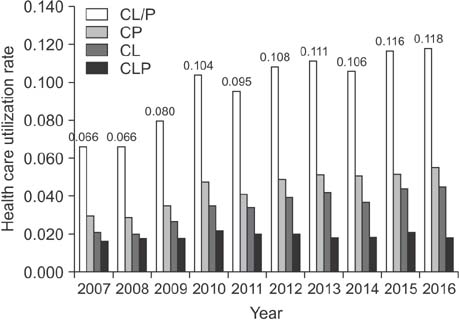Korean J Orthod.
2018 Jul;48(4):216-223. 10.4041/kjod.2018.48.4.216.
Trend of health care utilization of cleft lip and/or palate in Korea during 2007–2016
- Affiliations
-
- 1Department of Orthodontics, School of Dentistry, Kyungpook National University, Daegu, Korea.
- 2Department of Orthodontics, School of Dentistry, Seoul National University, Seoul, Korea. drwhite@unitel.co.kr
- 3Dental Research Institute, Seoul National University, Seoul, Korea.
- KMID: 2417963
- DOI: http://doi.org/10.4041/kjod.2018.48.4.216
Abstract
OBJECTIVE
This study is performed to investigate the trend of health care (HC) utilization among cleft lip and/or palate (CL/P) during 2007-2016 by using data from the Korean National Health Insurance Service (KNHIS).
METHODS
The KNHIS data were reorganized to count a specific patient only once for a specific year. Cleft type (cleft lip [CL], cleft palate [CP], and cleft lip and palate [CLP]), sex, and age at HC utilization were investigated. The study period was divided into the first half (2007-2011) and the last half (2012-2016). The utilization number and rate per 1,000 population were calculated for the total population and for new-born patients. Independent t-test and one-way analysis of variance were used for statistical analyses.
RESULTS
The total CL/P population (n = 48,707) comprised 19.2% CLP, 35.5% CL, and 45.3% CP (CLP < CL < CP; p < 0.001). Their HC utilization rate increased from 0.066 in 2007 to 0.118 in 2016. The new-born patient population (n = 7,617) comprised 18.6% CLP, 30.4% CL, and 51.0% CP (CLP < CL < CP; p < 0.001). Their HC utilization rate increased from 1.12 in 2007 to 1.74 in 2016. An examination of the utilization number and rate among new-born patients revealed CP exhibited a female-dominant pattern (all p < 0.01), while CL and CLP exhibited a male-dominant pattern (all p < 0.01). However, utilization number showed no difference by sex and cleft type between 2007-2011 and 2012-2016.
CONCLUSIONS
These results might serve as a guideline for HC utilization among patients with CL/P.
Keyword
MeSH Terms
Figure
Reference
-
1. Derijcke A, Eerens A, Carels C. The incidence of oral clefts: a review. Br J Oral Maxillofac Surg. 1996; 34:488–494.
Article2. IPDTOC Working Group. Prevalence at birth of cleft lip with or without cleft palate: data from the International Perinatal Database of Typical Oral Clefts (IPDTOC). Cleft Palate Craniofac J. 2011; 48:66–81.3. Rintala A, Stegars T. Increasing incidence of clefts in Finland: reliability of hospital records and central register of congenital malformations. Scand J Plast Reconstr Surg. 1982; 16:35–40.
Article4. Lei RL, Chen HS, Huang BY, Chen YC, Chen PK, Lee HY, et al. Population-based study of birth prevalence and factors associated with cleft lip and/or palate in Taiwan 2002–2009. PLoS One. 2013; 8:e58690.
Article5. Chang WJ, See LC, Lo LJ. Time trend of incidence rates of cleft lip/palate in Taiwan from 1994 to 2013. Biomed J. 2016; 39:150–154.
Article6. Mai CT, Cassell CH, Meyer RE, Isenburg J, Canfield MA, Rickard R, et al. National Birth Defects Prevention Network. Birth defects data from population-based birth defects surveillance programs in the United States, 2007 to 2011: highlighting orofacial clefts. Birth Defects Res A Clin Mol Teratol. 2014; 100:895–904.
Article7. Koga H, Iida K, Maeda T, Takahashi M, Fukushima N, Goshi T. Epidemiologic research on malformations associated with cleft lip and cleft palate in Japan. PLoS One. 2016; 11:e0149773.
Article8. Rozendaal AM, Luijsterburg AJ, Ongkosuwito EM, de Vries E, Vermeij-Keers C. Decreasing prevalence of oral cleft live births in the Netherlands, 1997–2006. Arch Dis Child Fetal Neonatal Ed. 2011; 96:F212–F216.
Article9. Shin KS, Lee YH, Lew JD. Cleft lip and cleft palate in Korea--2422 cases in 20 years. Yonsei Med J. 1985; 26:184–190.
Article10. Baik HS, Kim JH, Kim DJ. The prevalence of cleft lip and/or palate in Korean male adult. Korean J Orthod. 2001; 31:63–69.11. Baek SH, Moon HS, Yang WS. Cleft type and Angle's classification of malocclusion in Korean cleft patients. Eur J Orthod. 2002; 24:647–653.
Article12. Kim S, Kim WJ, Oh C, Kim JC. Cleft lip and palate incidence among the live births in the Republic of Korea. J Korean Med Sci. 2002; 17:49–52.
Article13. Kim MA, Yee NH, Choi JS, Choi JY, Seo K. Prevalence of birth defects in Korean livebirths, 2005–2006. J Korean Med Sci. 2012; 27:1233–1240.
Article14. Sousa GF, Roncalli AG. Orofacial clefts in Brazil and surgical rehabilitation under the Brazilian National Health System. Braz Oral Res. 2017; 31:e23.
Article
- Full Text Links
- Actions
-
Cited
- CITED
-
- Close
- Share
- Similar articles
-
- Orthodontic consideration of cleft lip and palate (Report 1)
- The use of classification in primary and secondary cleft lip and nose deformities in medical records
- A cephalometric study on the position of the hyoid bone in cleft lip and palate individuals
- Cleft lip and Palate Incidence Among the Live Births in the Republic of Korea
- A study on the craniofacial morphology of operated congenital cleft lip & palate



